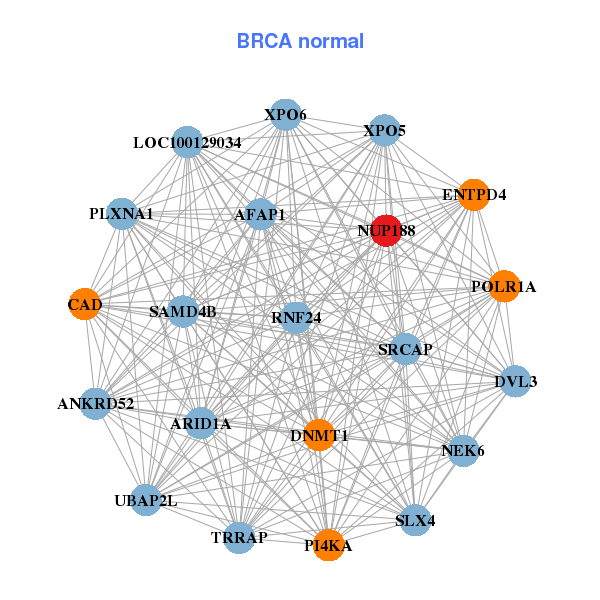|
||||||||||||||||||||||||||||||||||||||||||||||||||||||||||||||||||||||||||||||||||||||||||||||||||||||||||||||||||||||||||||||||||||||||||||||||||||||||||||||||||||||||||||||||||||||||||||||||||||||||||||||||||||||||||||||||||||||||||||||||||||||||||||||||||||||||||||||||||||||||||||||||||||||||||||||||||||||||||
| |
| Phenotypic Information (metabolism pathway, cancer, disease, phenome) |
| |
| |
| Gene-Gene Network Information: Co-Expression Network, Interacting Genes & KEGG |
| |
|
| Gene Summary for NUP188 |
| Basic gene info. | Gene symbol | NUP188 |
| Gene name | nucleoporin 188kDa | |
| Synonyms | KIAA0169|hNup188 | |
| Cytomap | UCSC genome browser: 9q34.11 | |
| Genomic location | chr9 :131709976-131769374 | |
| Type of gene | protein-coding | |
| RefGenes | NM_015354.2, | |
| Ensembl id | ENSG00000095319 | |
| Description | nucleoporin NUP188 homolog | |
| Modification date | 20141207 | |
| dbXrefs | MIM : 615587 | |
| HGNC : HGNC | ||
| Ensembl : ENSG00000095319 | ||
| HPRD : 18582 | ||
| Vega : OTTHUMG00000020768 | ||
| Protein | UniProt: go to UniProt's Cross Reference DB Table | |
| Expression | CleanEX: HS_NUP188 | |
| BioGPS: 23511 | ||
| Gene Expression Atlas: ENSG00000095319 | ||
| The Human Protein Atlas: ENSG00000095319 | ||
| Pathway | NCI Pathway Interaction Database: NUP188 | |
| KEGG: NUP188 | ||
| REACTOME: NUP188 | ||
| ConsensusPathDB | ||
| Pathway Commons: NUP188 | ||
| Metabolism | MetaCyc: NUP188 | |
| HUMANCyc: NUP188 | ||
| Regulation | Ensembl's Regulation: ENSG00000095319 | |
| miRBase: chr9 :131,709,976-131,769,374 | ||
| TargetScan: NM_015354 | ||
| cisRED: ENSG00000095319 | ||
| Context | iHOP: NUP188 | |
| cancer metabolism search in PubMed: NUP188 | ||
| UCL Cancer Institute: NUP188 | ||
| Assigned class in ccmGDB | C | |
| Top |
| Phenotypic Information for NUP188(metabolism pathway, cancer, disease, phenome) |
| Cancer | CGAP: NUP188 |
| Familial Cancer Database: NUP188 | |
| * This gene is included in those cancer gene databases. |
|
|
|
|
|
| . | ||||||||||||||||||||||||||||||||||||||||||||||||||||||||||||||||||||||||||||||||||||||||||||||||||||||||||||||||||||||||||||||||||||||||||||||||||||||||||||||||||||||||||||||||||||||||||||||||||||||||||||||||||||||||||||||||||||||||||||||||||||||||||||||||||||||||||||||||||||||||||||||||||||||||||||||||||||
Oncogene 1 | Significant driver gene in | |||||||||||||||||||||||||||||||||||||||||||||||||||||||||||||||||||||||||||||||||||||||||||||||||||||||||||||||||||||||||||||||||||||||||||||||||||||||||||||||||||||||||||||||||||||||||||||||||||||||||||||||||||||||||||||||||||||||||||||||||||||||||||||||||||||||||||||||||||||||||||||||||||||||||||||||||||||||||
| cf) number; DB name 1 Oncogene; http://nar.oxfordjournals.org/content/35/suppl_1/D721.long, 2 Tumor Suppressor gene; https://bioinfo.uth.edu/TSGene/, 3 Cancer Gene Census; http://www.nature.com/nrc/journal/v4/n3/abs/nrc1299.html, 4 CancerGenes; http://nar.oxfordjournals.org/content/35/suppl_1/D721.long, 5 Network of Cancer Gene; http://ncg.kcl.ac.uk/index.php, 1Therapeutic Vulnerabilities in Cancer; http://cbio.mskcc.org/cancergenomics/statius/ |
| REACTOME_METABOLISM_OF_NON_CODING_RNA REACTOME_METABOLISM_OF_RNA REACTOME_METABOLISM_OF_CARBOHYDRATES | |
| OMIM | |
| Orphanet | |
| Disease | KEGG Disease: NUP188 |
| MedGen: NUP188 (Human Medical Genetics with Condition) | |
| ClinVar: NUP188 | |
| Phenotype | MGI: NUP188 (International Mouse Phenotyping Consortium) |
| PhenomicDB: NUP188 | |
| Mutations for NUP188 |
| * Under tables are showing count per each tissue to give us broad intuition about tissue specific mutation patterns.You can go to the detailed page for each mutation database's web site. |
| - Statistics for Tissue and Mutation type | Top |
 |
| - For Inter-chromosomal Variations |
| * Inter-chromosomal variantions includes 'interchromosomal amplicon to amplicon', 'interchromosomal amplicon to non-amplified dna', 'interchromosomal insertion', 'Interchromosomal unknown type'. |
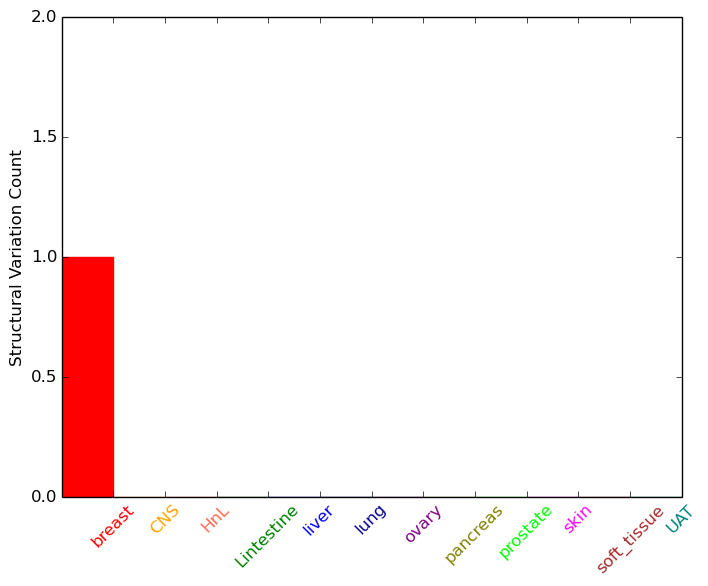 |
| - For Intra-chromosomal Variations |
| There's no intra-chromosomal structural variation. |
| Sample | Symbol_a | Chr_a | Start_a | End_a | Symbol_b | Chr_b | Start_b | End_b |
| cf) Tissue number; Tissue name (1;Breast, 2;Central_nervous_system, 3;Haematopoietic_and_lymphoid_tissue, 4;Large_intestine, 5;Liver, 6;Lung, 7;Ovary, 8;Pancreas, 9;Prostate, 10;Skin, 11;Soft_tissue, 12;Upper_aerodigestive_tract) |
| * From mRNA Sanger sequences, Chitars2.0 arranged chimeric transcripts. This table shows NUP188 related fusion information. |
| ID | Head Gene | Tail Gene | Accession | Gene_a | qStart_a | qEnd_a | Chromosome_a | tStart_a | tEnd_a | Gene_a | qStart_a | qEnd_a | Chromosome_a | tStart_a | tEnd_a |
| BE819347 | NUP188 | 3 | 151 | 9 | 131768587 | 131768868 | POLR2A | 138 | 287 | 17 | 7407022 | 7411630 | |
| BE819348 | NUP188 | 13 | 176 | 9 | 131768570 | 131768868 | POLR2A | 163 | 312 | 17 | 7407022 | 7411630 | |
| BG397339 | NUP188 | 47 | 104 | 9 | 131769268 | 131769325 | NUP188 | 100 | 165 | 9 | 131769308 | 131769373 | |
| BC071936 | NUP188 | 22 | 382 | 9 | 131768366 | 131768976 | PCNP | 363 | 908 | 3 | 101295262 | 101295811 | |
| T07564 | MAPK10 | 1 | 105 | 4 | 87205426 | 87205530 | NUP188 | 106 | 293 | 9 | 131761964 | 131763874 | |
| Top |
| Mutation type/ Tissue ID | brca | cns | cerv | endome | haematopo | kidn | Lintest | liver | lung | ns | ovary | pancre | prost | skin | stoma | thyro | urina | |||
| Total # sample | 1 | |||||||||||||||||||
| GAIN (# sample) | ||||||||||||||||||||
| LOSS (# sample) | 1 |
| cf) Tissue ID; Tissue type (1; Breast, 2; Central_nervous_system, 3; Cervix, 4; Endometrium, 5; Haematopoietic_and_lymphoid_tissue, 6; Kidney, 7; Large_intestine, 8; Liver, 9; Lung, 10; NS, 11; Ovary, 12; Pancreas, 13; Prostate, 14; Skin, 15; Stomach, 16; Thyroid, 17; Urinary_tract) |
| Top |
|
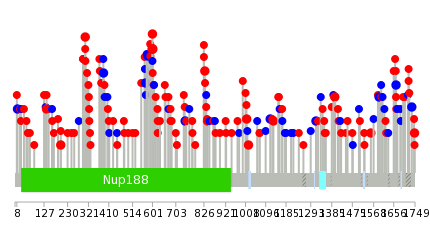 |
| Top |
| Stat. for Non-Synonymous SNVs (# total SNVs=105) | (# total SNVs=44) |
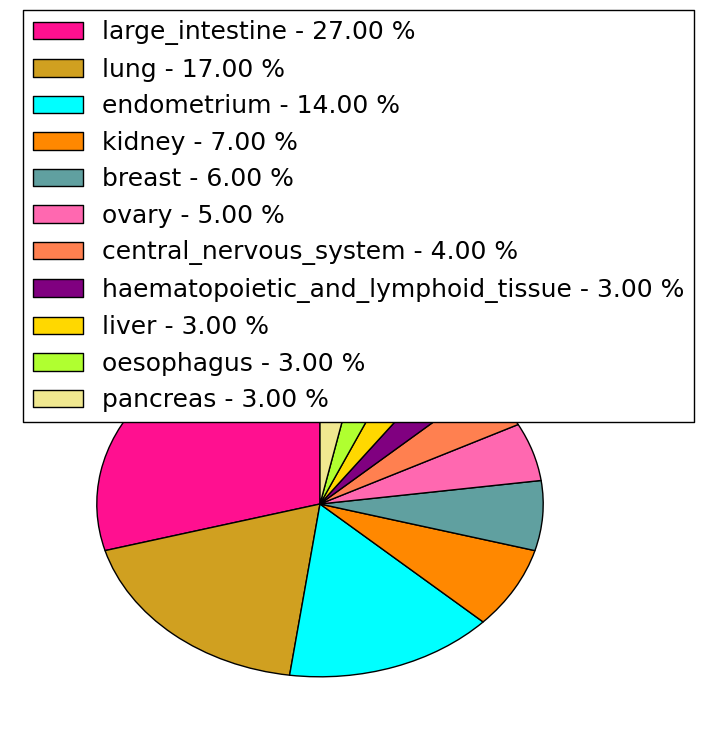 |  |
(# total SNVs=0) | (# total SNVs=1) |
 |
| Top |
| * When you move the cursor on each content, you can see more deailed mutation information on the Tooltip. Those are primary_site,primary_histology,mutation(aa),pubmedID. |
| GRCh37 position | Mutation(aa) | Unique sampleID count |
| chr9:131745577-131745577 | p.T601M | 3 |
| chr9:131730845-131730845 | p.E216* | 3 |
| chr9:131768946-131768946 | p.M1747L | 2 |
| chr9:131760467-131760467 | p.R1130H | 2 |
| chr9:131750408-131750408 | p.R826G | 2 |
| chr9:131750420-131750420 | p.P830S | 2 |
| chr9:131745645-131745645 | p.R624S | 2 |
| chr9:131756671-131756671 | p.L1013V | 2 |
| chr9:131767740-131767740 | p.K1556N | 2 |
| chr9:131745576-131745576 | p.T601A | 2 |
| Top |
|
 |
| Point Mutation/ Tissue ID | 1 | 2 | 3 | 4 | 5 | 6 | 7 | 8 | 9 | 10 | 11 | 12 | 13 | 14 | 15 | 16 | 17 | 18 | 19 | 20 |
| # sample | 8 | 4 | 20 | 1 | 4 | 2 | 19 | 7 | 5 | 1 | 11 | 16 | 16 | |||||||
| # mutation | 8 | 4 | 18 | 1 | 4 | 2 | 20 | 7 | 5 | 1 | 13 | 23 | 20 | |||||||
| nonsynonymous SNV | 6 | 1 | 15 | 1 | 3 | 1 | 13 | 4 | 3 | 1 | 6 | 16 | 13 | |||||||
| synonymous SNV | 2 | 3 | 3 | 1 | 1 | 7 | 3 | 2 | 7 | 7 | 7 |
| cf) Tissue ID; Tissue type (1; BLCA[Bladder Urothelial Carcinoma], 2; BRCA[Breast invasive carcinoma], 3; CESC[Cervical squamous cell carcinoma and endocervical adenocarcinoma], 4; COAD[Colon adenocarcinoma], 5; GBM[Glioblastoma multiforme], 6; Glioma Low Grade, 7; HNSC[Head and Neck squamous cell carcinoma], 8; KICH[Kidney Chromophobe], 9; KIRC[Kidney renal clear cell carcinoma], 10; KIRP[Kidney renal papillary cell carcinoma], 11; LAML[Acute Myeloid Leukemia], 12; LUAD[Lung adenocarcinoma], 13; LUSC[Lung squamous cell carcinoma], 14; OV[Ovarian serous cystadenocarcinoma ], 15; PAAD[Pancreatic adenocarcinoma], 16; PRAD[Prostate adenocarcinoma], 17; SKCM[Skin Cutaneous Melanoma], 18:STAD[Stomach adenocarcinoma], 19:THCA[Thyroid carcinoma], 20:UCEC[Uterine Corpus Endometrial Carcinoma]) |
| Top |
| * We represented just top 10 SNVs. When you move the cursor on each content, you can see more deailed mutation information on the Tooltip. Those are primary_site, primary_histology, mutation(aa), pubmedID. |
| Genomic Position | Mutation(aa) | Unique sampleID count |
| chr9:131745577 | p.T601M | 3 |
| chr9:131733044 | p.F387F | 2 |
| chr9:131760467 | p.A1666A | 2 |
| chr9:131745254 | p.S581S | 2 |
| chr9:131730798 | p.V200A | 2 |
| chr9:131745576 | p.T601A | 2 |
| chr9:131735486 | p.D307G | 2 |
| chr9:131768572 | p.R1130H | 2 |
| chr9:131721088 | p.D1135D | 1 |
| chr9:131744890 | p.T134T | 1 |
| * Copy number data were extracted from TCGA using R package TCGA-Assembler. The URLs of all public data files on TCGA DCC data server were gathered on Jan-05-2015. Function ProcessCNAData in TCGA-Assembler package was used to obtain gene-level copy number value which is calculated as the average copy number of the genomic region of a gene. |
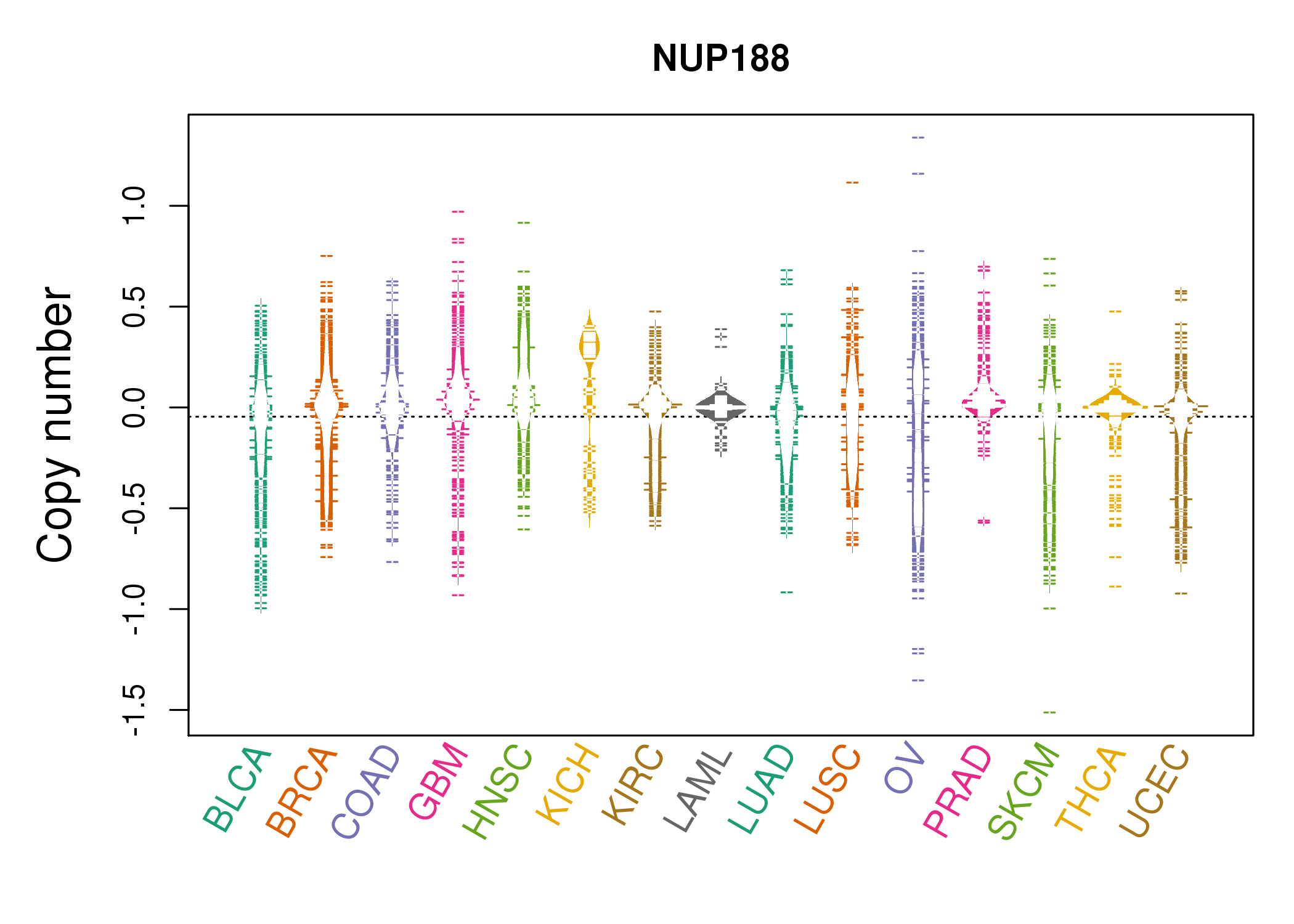 |
| cf) Tissue ID[Tissue type]: BLCA[Bladder Urothelial Carcinoma], BRCA[Breast invasive carcinoma], CESC[Cervical squamous cell carcinoma and endocervical adenocarcinoma], COAD[Colon adenocarcinoma], GBM[Glioblastoma multiforme], Glioma Low Grade, HNSC[Head and Neck squamous cell carcinoma], KICH[Kidney Chromophobe], KIRC[Kidney renal clear cell carcinoma], KIRP[Kidney renal papillary cell carcinoma], LAML[Acute Myeloid Leukemia], LUAD[Lung adenocarcinoma], LUSC[Lung squamous cell carcinoma], OV[Ovarian serous cystadenocarcinoma ], PAAD[Pancreatic adenocarcinoma], PRAD[Prostate adenocarcinoma], SKCM[Skin Cutaneous Melanoma], STAD[Stomach adenocarcinoma], THCA[Thyroid carcinoma], UCEC[Uterine Corpus Endometrial Carcinoma] |
| Top |
| Gene Expression for NUP188 |
| * CCLE gene expression data were extracted from CCLE_Expression_Entrez_2012-10-18.res: Gene-centric RMA-normalized mRNA expression data. |
 |
| * Normalized gene expression data of RNASeqV2 was extracted from TCGA using R package TCGA-Assembler. The URLs of all public data files on TCGA DCC data server were gathered at Jan-05-2015. Only eight cancer types have enough normal control samples for differential expression analysis. (t test, adjusted p<0.05 (using Benjamini-Hochberg FDR)) |
 |
| Top |
| * This plots show the correlation between CNV and gene expression. |
: Open all plots for all cancer types
 |
|
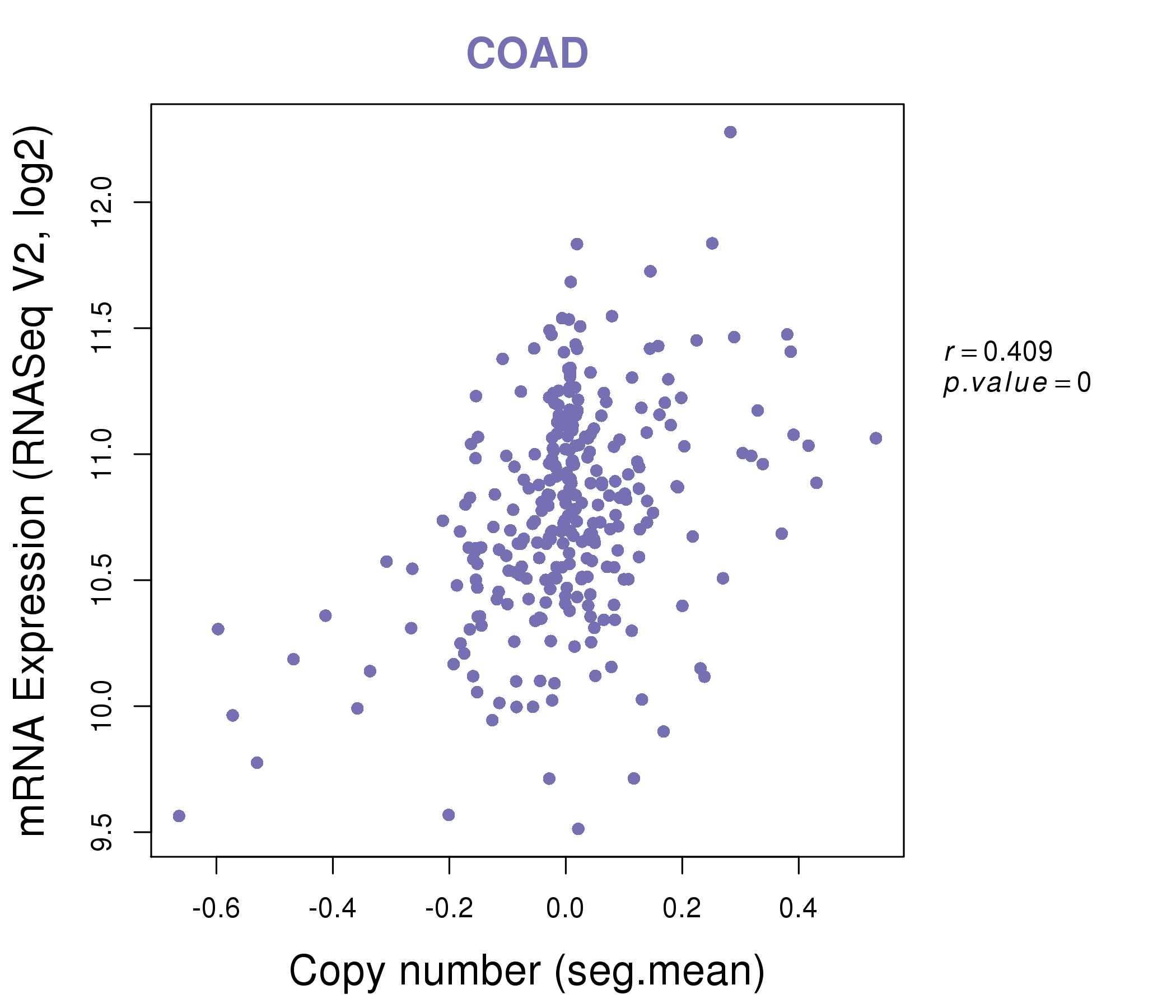 |
|
| Top |
| Gene-Gene Network Information |
| * Co-Expression network figures were drawn using R package igraph. Only the top 20 genes with the highest correlations were shown. Red circle: input gene, orange circle: cell metabolism gene, sky circle: other gene |
: Open all plots for all cancer types
 |
|
| BUB1B,CAMSAP1,CKAP2L,CLSPN,DDX31,DOLPP1,EXOSC2, FANCC,GLE1,GTF3C4,LMNB1,LOC441089,NCBP1,NUP188, NUP214,NUSAP1,ODF2,POLE3,SET,SMC2,TTF1 | AFAP1,ANKRD52,ARID1A,SLX4,CAD,DNMT1,DVL3, ENTPD4,LOC100129034,NEK6,NUP188,PI4KA,PLXNA1,POLR1A, RNF24,SAMD4B,SRCAP,TRRAP,UBAP2L,XPO5,XPO6 |
 |
|
| CAMSAP1,CDCA2,CDK5RAP2,CEP78,CHAF1A,CLSPN,DNMT1, FANCC,GSG2,GTF3C4,INCENP,LMNB2,MKI67,NUP188, ORC1,SEC16A,SMC2,UHRF1,WDHD1,WDR76,WHSC1 | BMS1,CAD,CKAP5,ILF3,KHSRP,MDC1,NAT10, NCL,NUP188,NUP205,ODF2,PFAS,POLR1A,PRKDC, RBM19,TCHP,TCOF1,UBAP2L,URB1,UTP20,ZC3H18 |
| * Co-Expression network figures were drawn using R package igraph. Only the top 20 genes with the highest correlations were shown. Red circle: input gene, orange circle: cell metabolism gene, sky circle: other gene |
: Open all plots for all cancer types
| Top |
: Open all interacting genes' information including KEGG pathway for all interacting genes from DAVID
| Top |
| Pharmacological Information for NUP188 |
| There's no related Drug. |
| Top |
| Cross referenced IDs for NUP188 |
| * We obtained these cross-references from Uniprot database. It covers 150 different DBs, 18 categories. http://www.uniprot.org/help/cross_references_section |
: Open all cross reference information
|
Copyright © 2016-Present - The Univsersity of Texas Health Science Center at Houston @ |








